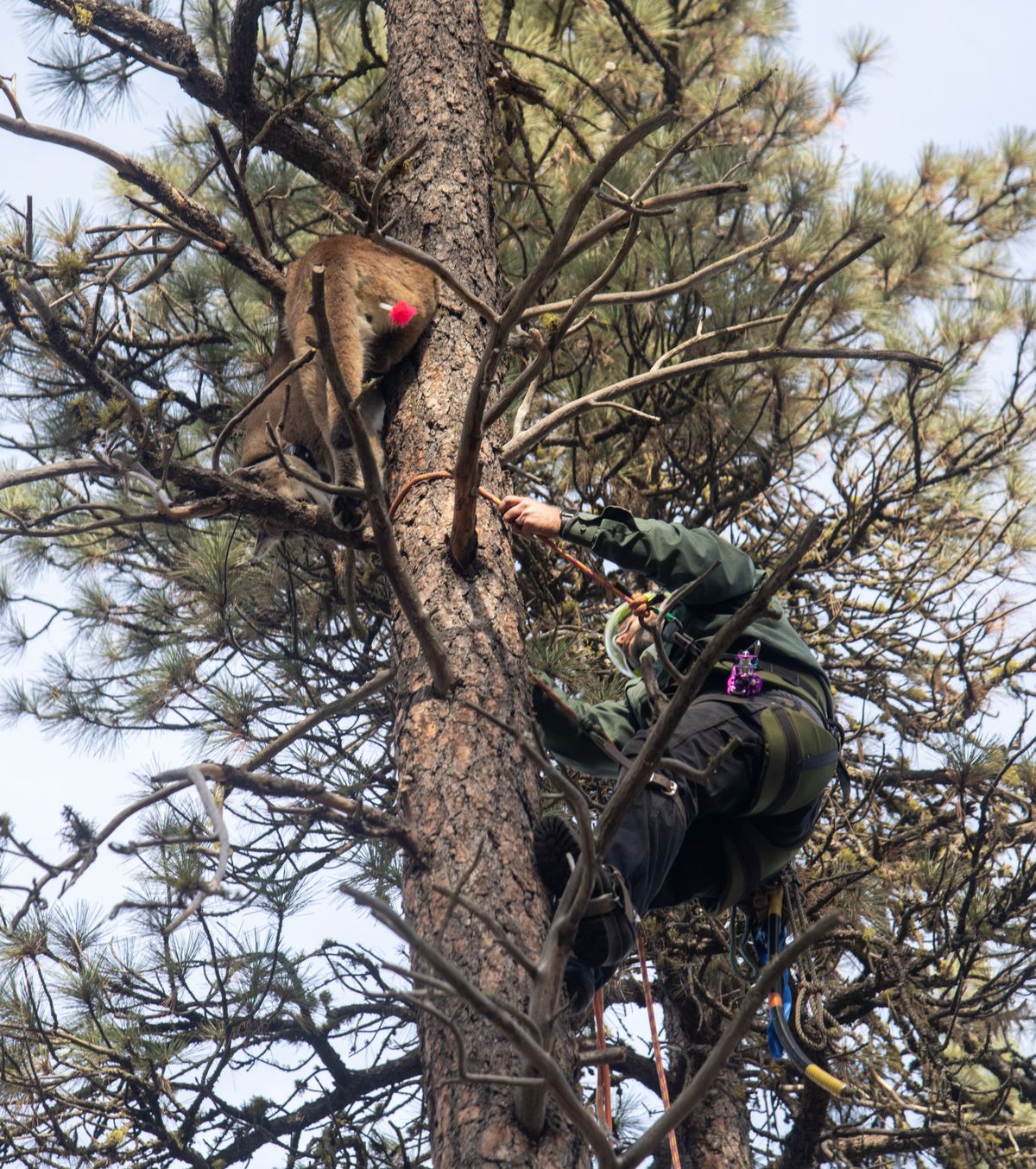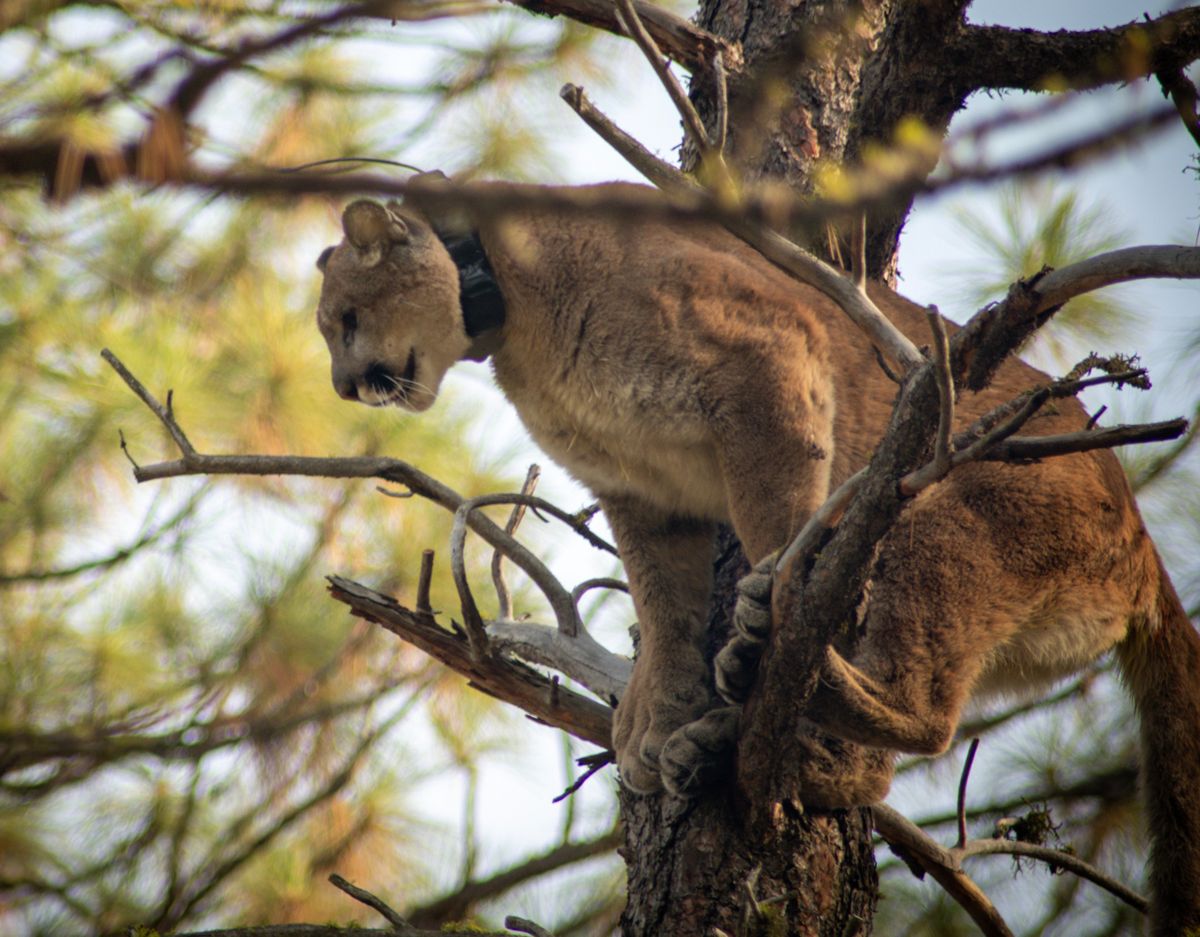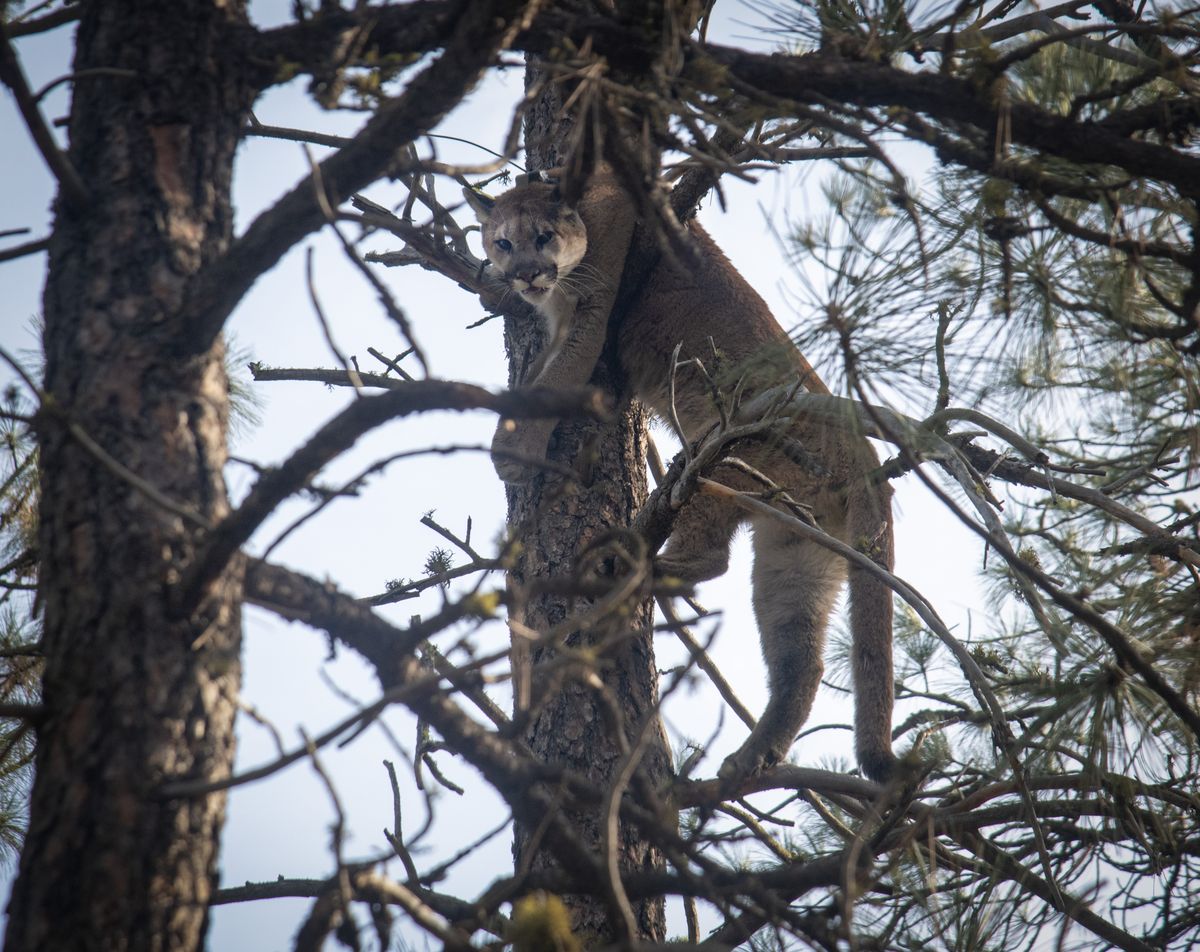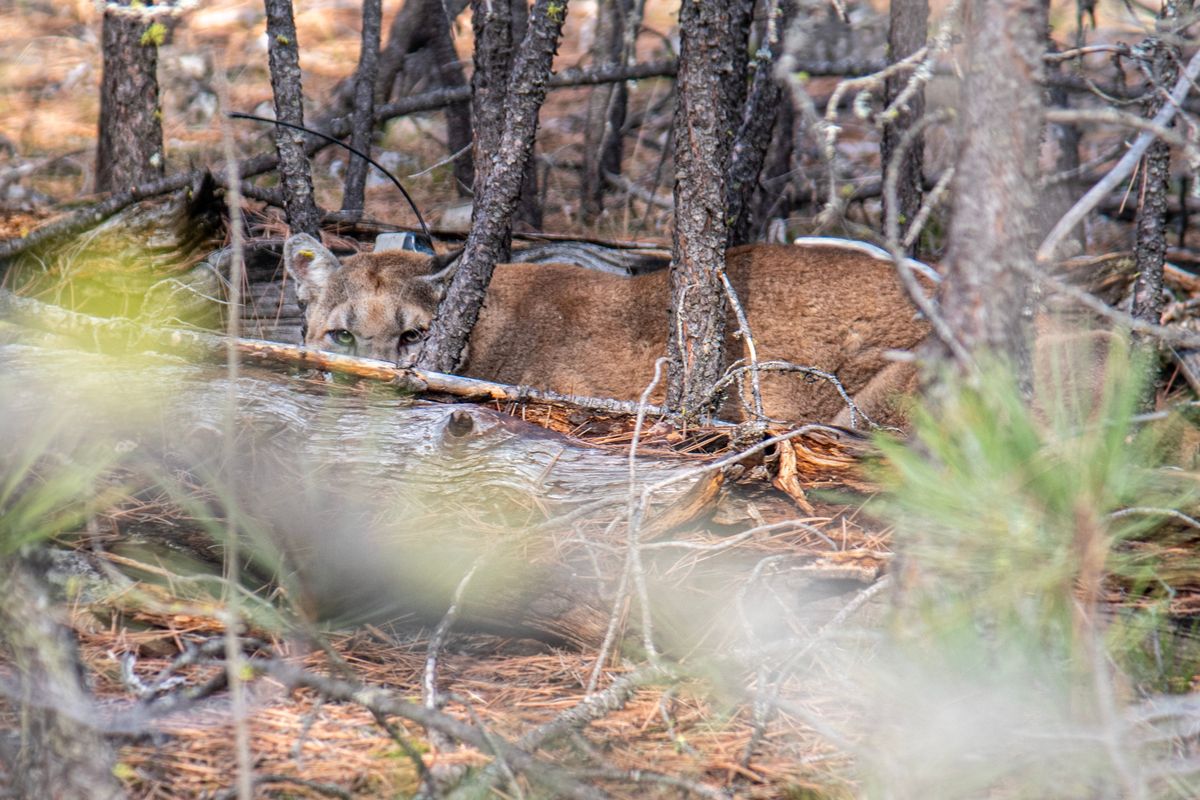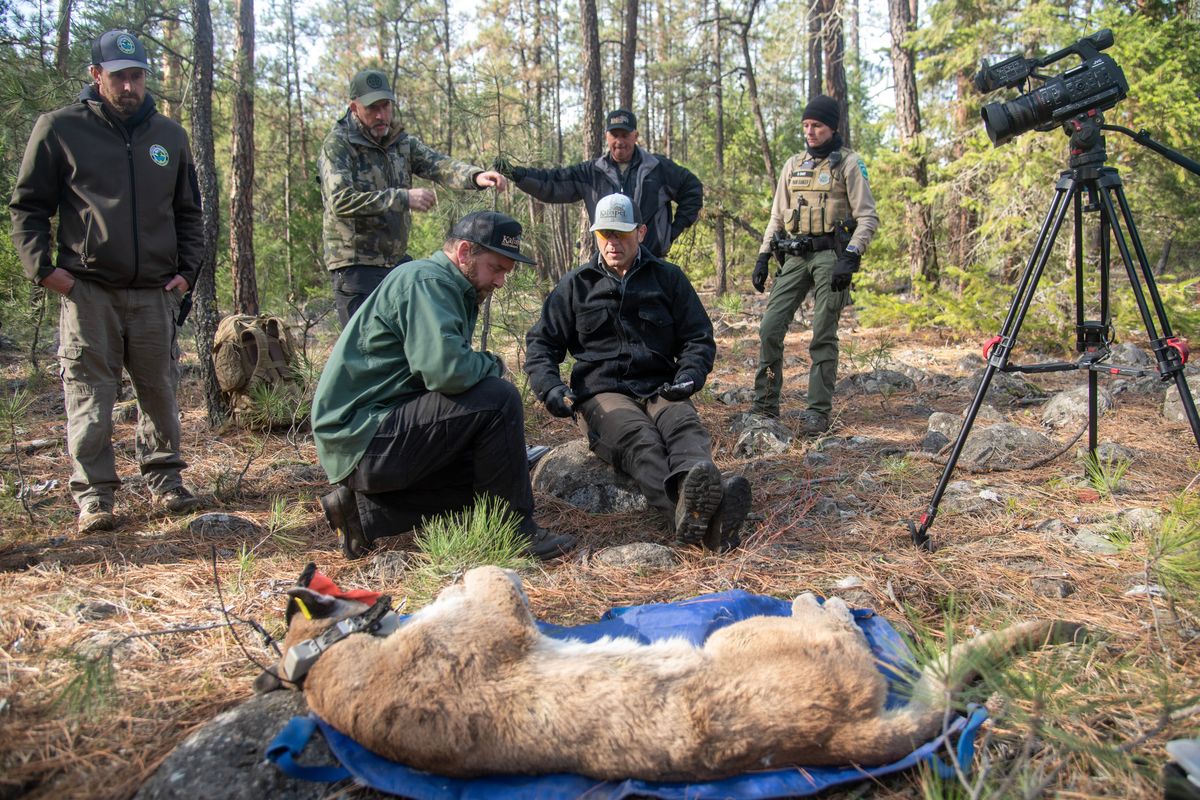Learning from cats: Cougar spotted at Riverside State Park now part of research project
A cougar is cornered in a tree in Riverside State Park on Oct. 31. (Michael Wright/THE SPOKESMAN-REVIEW)
The cougar wasn’t far away when Bart George started walking a trail at Riverside State Park on Tuesday.
A handheld GPS device told George, the wildlife program manager for the Kalispel Tribe, that the cat was a little ways south and just downhill from him, a few hundred yards away. He turned on a Bluetooth speaker and a podcast broke the morning silence.
As the recorded voices discussed the merits of astrology, George looked down into Seven Mile Canyon. Patches of grass and thick cover mixed with the occasional tall pine on the hillside below him. The GPS signal seemed to be coming from one island of medium-sized trees at the bottom, the steep slope on one side and another trail on the other.
“He’s going to be right there in that copse of trees,” George said.
Back in the parking lot, about a dozen people waited – George’s staff and officials from the state park and the Washington Department of Fish and Wildlife – along with four hounds itching to put a cougar in a tree.
Before they could join him, though, George wanted to approach the animal on his own. It’s part of a study he’s leading on what cougars do when they hear human voices – in this case, a podcast – and how close the voices need to be to make the animal flee.
This would be the fourth time he approached this particular cat. He left the trail and side-hilled his way around the animal’s hiding spot, navigating through thick brush and over downed logs.
At one point, he heard voices that weren’t coming from the speaker. He stopped and listened. Two men were walking the trail at the bottom of the canyon.
When their voices faded, George continued down. He got to the trail and walked slowly, lining himself up with the GPS signal. A can of bear spray in one hand, he stepped into the trees and looked.
The cougar’s tawny, brown hide stood out in the shadows, on the ground about 10 yards off the trail.
It wasn’t moving. George made some noise, hoping it would react. It didn’t.
“That’s a habituated lion,” George said. “That’s what we don’t want.”
He radioed back to the parking lot, telling the people there that it was time to set the dogs loose. Howls and barks echoed down the canyon, and George backed away.
The cougar’s indifference to his presence isn’t unusual after he’s approached a cat multiple times. The animal seems to know nothing bad is going to happen. That doesn’t inherently mean it’s dangerous – attacks on humans are rare – just that it lacks a healthy fear of people.
“Even on the walk down here, we heard those two men walk this trail just jabbering,” he said. “They walked within 10 yards of that cat. Is there a risk for those people? Pretty low. … It’s just something to be mindful of.”
The dogs followed George’s scent down the hill and dashed toward the cougar’s hideout. Soon, they were gathered at the base of a tall pine, howling to the sky.
Some 70 or 80 feet up, the cougar perched on a branch, its morning disrupted.
Research subject
Cougars sneak through the woods all over Washington, and they can be hard to count. WDFW’s 2022 estimate put the number at about 3,600 cougars statewide, but when George gets asked how many there are, he tells people that any habitat that should have cougars probably does.
“Cougars are everywhere they belong,” he said.
Sometimes, the place they belong is also one that’s full of people, like Riverside State Park. The cats usually stay hidden, until they don’t.
A little more than two weeks before George was walking up to that cougar in Seven Mile Canyon, the cat was spotted on a trail in the park, following a mountain biker.
The biker told KXLY that he yelled and shook his bike at the cat, and it backed off. He kept riding. He saw the cougar one more time, but was able to walk away without injury.
The incident prompted Washington State Parks to reach out to George.
George has a team of hounds and has been treeing and handling mountain lions for a long time. Over the past three years, he’s also been studying the cats’ responses to human voices, and whether their behavior can be changed through hazing. The idea is to get the cats to associate the sound of humans with a negative experience, and get them to flee when people approach.
First, he approaches them multiple times without dogs, just him and the speaker playing a podcast. He tracks how close the cougar lets him get before it runs, and, when it does run, how far it goes. That’s called the control phase.
During the hazing phase, he approaches again and eventually brings in the hounds to tree the cat and uses other methods to scare the animal.
George has put more than 40 cougars from all over the region through the study. He plans to write up the results next spring. So far, the data shows that the hazing works.
By the end of the control phase, he typically finds that the cats are comfortable letting people get close to them, expecting that nothing bad is going to happen to them. But once the cougars experience the hazing, they begin reacting more strongly to the sound of people approaching, fleeing sooner and farther.
“By the end of the study, the cats are not letting us get as close to them and they are moving farther away from us,” he said.
Sgt. Tony Leonetti, a law enforcement officer with WDFW, said the study has already given the agency a new way to deal with cougars reported in places close to people.
Instead of just giving advice on how to prevent further conflict, they can call George to come and get a close look at the cat. They can figure out if it’s healthy, or if it has kittens, or if there’s a reason it’s hanging out close to people. And, if it fits the parameters of the study, George will run it through the protocols and hopefully change its behavior.
“It gives us a nonlethal tool to use when people call in cougar sightings in their driveways, or in their yard,” Leonetti said.
Those sorts of calls are how George has found most of his research subjects, like the cougar that chased the mountain biker at Riverside State Park.
Mere hours after the incident was reported, George and his team trapped it. It’s a male, about 4 years old. Because it was in good shape, and because it hadn’t actually attacked the cyclist, it was a good candidate for the research project.
“He was healthy, and just made a bad choice,” George said. “So we elected to put a collar on him and see if we could learn something from him.”
Up close
Tuesday was the last “control point” for the study of the cougar in the park. George is going to revisit it four more times to run through the hazing part of the study. To ensure he can do that, though, he needed to replace the batteries in its GPS collar – a move that should buy them another month of following the animal.
That meant that once it was treed, they needed to tranquilize it and bring it down to the ground.
The first tree the cat climbed was too tall. It was also partway up the steep hillside on the edge of the canyon. A bad place to try to bring it down without hurting it.
The hounds were called off and moved away so George and the others could try to coax the animal out of the tree.
It took a while. George peppered the tree with a paintball gun. One of his biologists hit the stump with a branch. The cougar switched trees, but otherwise seemed unbothered.
Jeff Flood, a wildlife specialist with the Stevens and Ferry county sheriff’s offices, donned climbing gear and scaled one of the trees until he was nearly eye-level with the cougar. He shot a few more paintballs, waved some branches, hissed at it.
Finally, the cougar pointed its head down and descended the tree, all athleticism and grace. It bounded away, past its original daybed, across the trail and over to a flat spot.
The dogs were set loose, and the chorus of howls filled the air again. Soon, the cat was treed again – this time, low enough for some work to get done.
George shot it with a tranquilizer dart and it was carefully lowered to the ground and laid on a tarp. As the animal slept, the people who had been following it all day gathered around it.
They slipped a blinder over its eyes and removed the collar. They examined its paws and its teeth. Its chest was full of porcupine quills; George and Flood carefully pulled out each one.
About an hour after it was put to sleep, the work was over. The collar was reattached, and the cat was injected with a drug meant to reverse the effects of the tranquilizer. Within a few minutes, it walked into the forest and sat down behind a log. The people who had been following it all day packed up and left.
George will be back soon. Once he’s finished the hazing portion of the study, he’ll remove the collar. By that point, the cougar will hopefully have the same response as the rest of the animals George has analyzed – a fear of human interaction, and a reduced chance of serious conflict.
“The best-case scenario would be for us to haze this cat, get him to have a healthy fear of people and human interactions and have him maintain this territory,” George said. “There’s going to be a cougar in the park, so we may as well have it be one that got hazed.”
But in reality, it’s unlikely the cougar will spend its whole life in the state park. A cougar’s home range can get as big as 100 square miles. In the past, George has seen them wander long distances, from Priest Lake up into Canada, from Chewelah over to Mount Baker.
Where this one will go is anyone’s guess, George said.
“There’s no reason for him to leave, really,” George said. “They don’t need a reason. They just like to wander like we do.”

